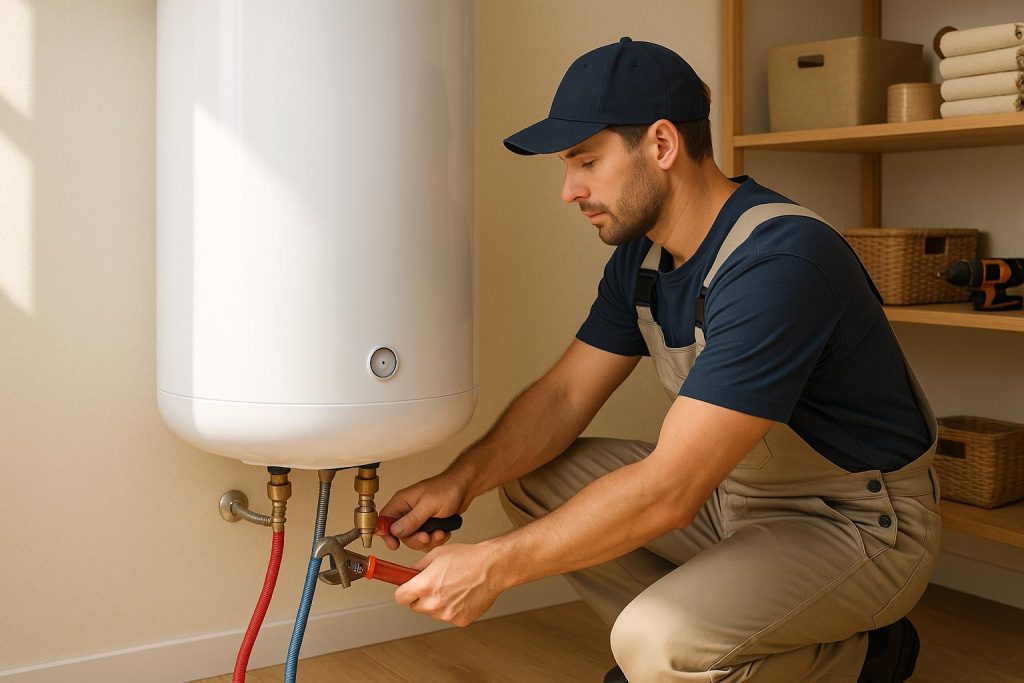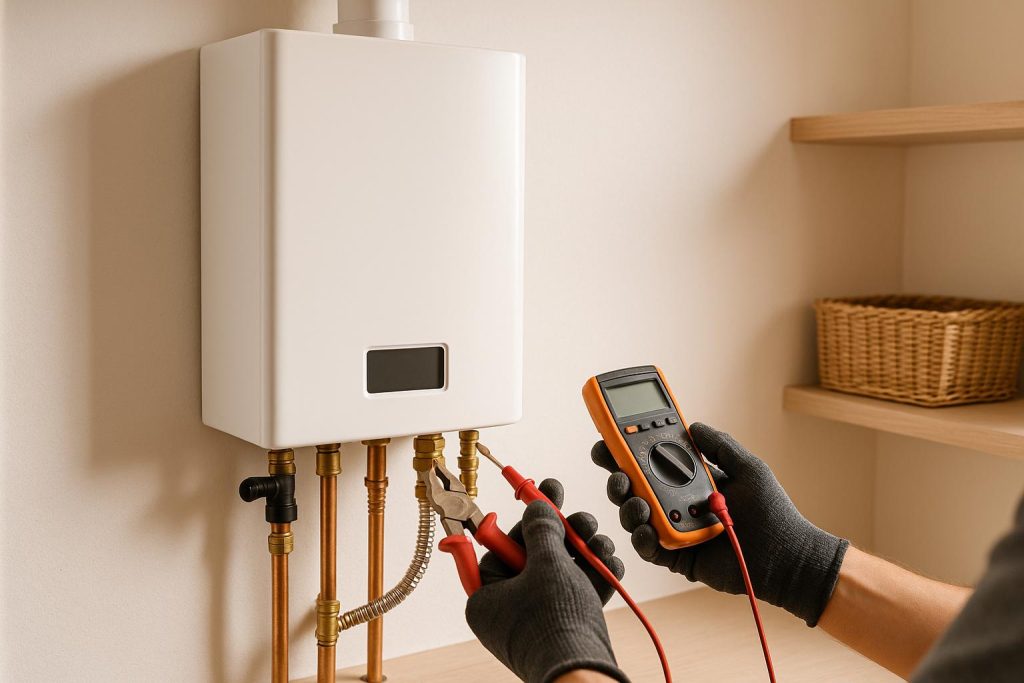
To quickly turn off the water supply for repairs, follow these steps:
- Locate the Main Shut-Off Valve: The main shut-off valve is typically located near the point where the main water line enters your home. Common locations include the basement, crawlspace, utility room, or near the water meter.
- Clear the Area: Ensure that the area around the shut-off valve is clear of any obstacles, making it easy to access.
- Gather Necessary Tools: You may need a wrench or pliers to turn the valve, depending on the type of valve installed.
- Identify the Valve Type: There are two common types of main shut-off valves:
- Gate Valve: A gate valve has a round wheel-like handle that you need to turn clockwise (right) to shut off the water supply. This type of valve may require multiple turns to fully close.
- Ball Valve: A ball valve has a lever handle that you need to turn 90 degrees to the perpendicular position (from parallel) to shut off the water. Ball valves are often preferred for their ease of use.
- Turn Off the Valve: Using your hand, a wrench, or pliers, turn the valve in the appropriate direction to shut off the water supply. Ensure that the valve is fully closed.
- Check for Water Flow: To confirm that the water supply is off, open a faucet or fixture in your home and check if water continues to flow. If there’s no water flow, the main shut-off valve is successfully closed.
- Perform Repairs: With the water supply off, proceed with your repair or maintenance work.
- Turn On the Valve: Once you’ve completed the repairs, return to the main shut-off valve and turn it counterclockwise (left) to reopen it fully. This will restore water flow throughout your home.
- Check for Leaks: After reopening the valve, inspect your repair area and the surrounding connections for any signs of leaks. Address any issues promptly.
- Cleanup: Ensure that the area is clear and any tools or equipment used during the repair are properly stored.
Kitchen or Bathroom Sink
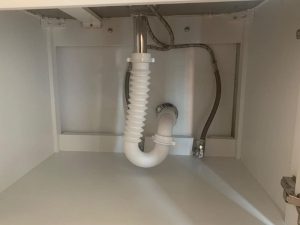
Both kitchen and bathroom sinks have 2 shut off valves, one for the cold water and the other for the hot water. When doing any repairs like replacing the faucet or cartridge, you will need to turn off both shut off valves.
To turn off water to a kitchen or bathroom sink, look for 2 (usually oval-shaped) valves on the wall under the sink with 2 flexible hoses connected to them. Turn them all the way clockwise to turn off the cold and hot water supply to the sink faucet.
Toilet

A toilet does not need hot water. It is supplied with cold water by a supply line which is connected to the toilet fill valve from underneath the toilet tank.
To turn off water to a toilet, look for a shut off valve connected to the flexible water supply pipe on the wall behind the toilet. Turn the valve all the way clockwise. Flush the toilet and if you don’t hear the tank refilling then it is a confirmation that the valve is fully closed.
Due to the fact that this valve is hardly used, it may be stuck in the open position (usually due to mineral deposits and closing it will be almost impossible.
What you can do in that case is remove the toilet tank lid and lift the toilet float (connected to the fill valve) all the way up. You can use a piece of wood to support the float in that position.
With the toilet float up, the fill valve is closed and the toilet will not fill with water. This will only work if you are working on the other parts and not replacing the fill valve or the toilet itself. In that case you will have to turn off water to the entire house.
Dishwasher
Dishwashers are supplied with water by the same pipes as the kitchen sink faucets. They however have separate shut off valves and water supply houses from the sink faucets.
To make this possible, 2 tees are installed on both the cold and hot water supply pipes. This enables both cold and hot water to flow to the faucet as well as dishwashers.
To turn off water to a dishwasher, look for shut off valves on the horizontal pipes under the kitchen sink. Turn the valves clockwise.
Refrigerator Ice Maker or Water Dispenser

Your refrigerator’s shut off valve will be located on the wall behind the refrigerator or underneath the kitchen sink. Sometimes it will also be in the basement or crawl space. The refrigerator’s water supply hose should guide you to where the shut off valve is.
If the shut off valve is on the wall behind the refrigerator, pull the refrigerator forward gently to access the shut off valve and turn it clockwise. For a refrigerator with a shut off valve under the kitchen sink, take your time to locate the right valve and turn it clockwise as well.
Washing Machine
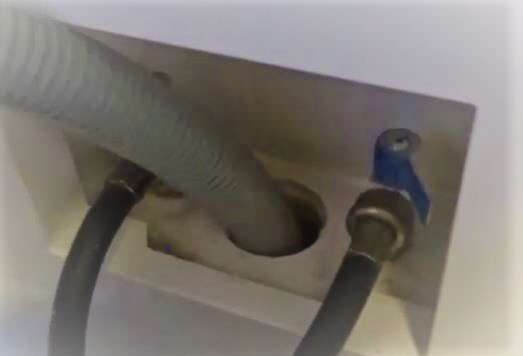
Your washing machine will most likely be located on the wall behind the washer. It is also where washer drains from. The valves may also be located in a utility sink if your washing machine has one.
To turn off water to the washing machine, pull it slightly and gently forward to access the valves. There will be a cold and hot water supply hose and valve. Turn both the valves clockwise.
Shower/Bathtub
If you need to perform repairs on your shower/bathtub faucet or valve, turning off water to the to the faucet is not always easy.
To turn off the water to your shower/bathtub, look for shut off valves from an access panel behind the shower wall. If there is no access panel, you need to remove the faucet handle and escutcheon and check if the shower valve has shut off valves. Turn off water to the whole house if there are no valves on the shower valve.
If you are lucky, there will be an access panel on the wall behind the shower which you can remove and shut off water to the tub/shower faucet. The panel may also be found on the basement or ceiling of the underneath floor.
If you can’t see any access panels, there is one thing you can do before turning off water to the entire house. Remove the shower faucet handle and escutcheon.
- If you have a single-lever shower faucet handle, look for a hex screw underneath the lever. Remove it with an Allen wrench and pull out the handle.
- For a knob-type handle, remove the small cover at the tip of the handle and remove the screw connecting the handle with a Philips screwdriver.
- Remove the escutcheon. An escutcheon is the trim plate which is purely for cosmetic purposes. It will either be installed using screws or it could be threaded on the faucet. Also, check if it is caulked to the wall and cut the caulk with a knife.
- With the handle and escutcheon out, you can see the shower valve. Check if there are 2 screws on each side of the shower valve. Those are the cold and hot water shut off valves. They are closed and opened using a screwdriver.
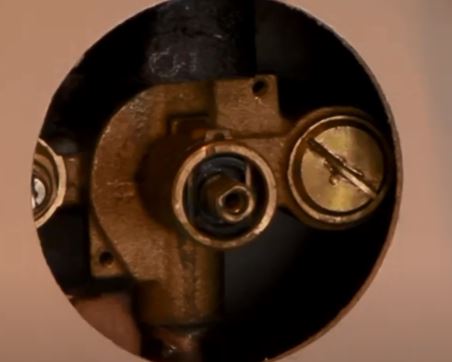
If your shower valve has no shut off valves you will need to turn off your main house shut off valve.
Water Heater

A water heater has 2 water pipes connected to it. The cold water pipe supplies it with cold water while the hot water pipe supplies it with hot water. Each of the 2 pipes has a shut off valve.
If you want to turn off hot water to your house you simply turn off the valve on the hot water pipe. To turn off cold water supply to the water heater you will need to turn the valve on the cold water line.
The types of valves used here are the lever-type valves. To turn the valve off, position the lever at 90 degrees to the water pipe. When the lever is aligned with the water pipe the valve is opened.
Whenever you are repairing the water heater it is always advisable to first turn off power or gas supply to the water heater. You will also need to drain off some water from the tank to make the water heater safe to work on.
Main House Shut off Valve
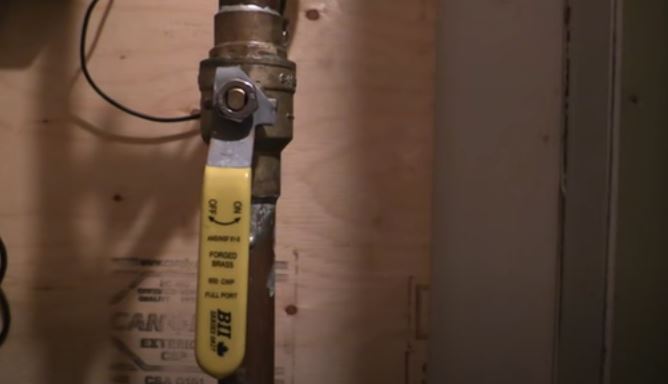
If you have a leak in your water pipes, you will need to shut off your main house shut off valve. This valve cuts off the water supply to your entire house making it safe in preventing water damages especially in the case of a burst pipes.
Main shut off valves will either be located inside the house or outside the house on the street side. Start by looking inside utility areas like garage, basement, crawlspace, laundry room etc.
Shut off valves will be located very close to the water heater in the basement. The main water pipes where the valve is will be high (eye-level or higher) while on main floors it will be lower.
If you live in a warmer area, the shut off valve will be located on external wall, usually where the main water line enters the building.
For a gate valve (looks like a knob) you will need to turn the knob clockwise. The valve is always open so you will need to apply more force to turn it off.
If you have a ball valve, you will need to move the lever perpendicular (90 degrees) to the supply pipe to turn it off.
Once you have turned off the main shut off valve, open all the faucets to drain the water still left in the pipes. When you are done with the repairs you need to be methodical when turning back the water supply to prevent airlock in the pipes.
Note: When turning off the main shut off valve, I always recommend turning off power to the water heater as well. This will prevent burning of the heating elements if hot water is drawn from the tank.
At the Water Meter
If you have an underground leak (especially between the water meter and the shut off valve) turning off water at the water meter makes sense. You should do this only as the last resort.
Your water meter is usually located between your house and the street, near the curb or sidewalk. It is found inside a concrete box with a metal or plastic lid with“Water” or “Water Meter” inscribed at the top.
There are usually 2 shut off valves, one on the city’s side and one on your side as the homeowner. That is the valve that you need to turn off.
And basically that is how you turn off water to your house for plumbing repairs. I hope this guide was of help to you.



